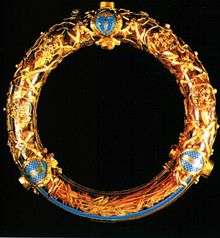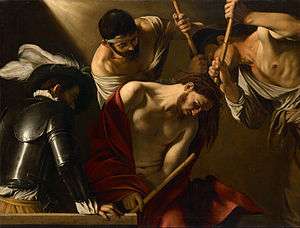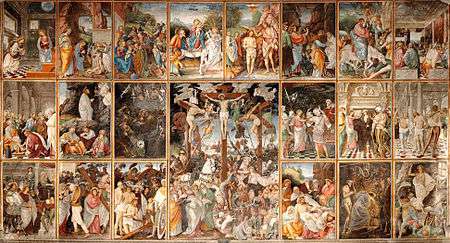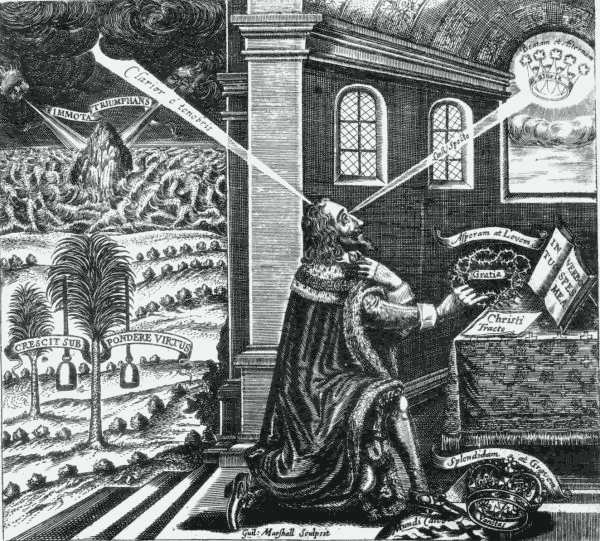Crown of thorns

According to three of the canonical Gospels a woven crown of thorns was placed on the head of Jesus during the events leading up to the crucifixion of Jesus. It was one of the instruments of the Passion, employed by Jesus' captors both to cause him pain and to mock his claim of authority. It is mentioned in the gospels of Matthew (27:29), Mark (15:17), and John (19:2, 5) and is often alluded to by the early Church Fathers, such as Clement of Alexandria, Origen, and others.
In later centuries, relics believed by many to be all or part of the Crown of Thorns have been venerated.
As a relic
Jerusalem
A few writers of the first six centuries AD speak of a relic known to be still in existence and venerated by the faithful. St. Paulinus of Nola, writing after 409, refers to "the thorns with which Our Saviour was crowned" as relics held in honour along with the Cross to which he was nailed and the pillar at which he was scourged (Epistle Macarius in Migne, Patrologia Latina, LXI, 407). Cassiodorus (c. 570), when commenting on Psalm lxxxvi, speaks of the crown of thorns among the other relics which are the glory of the earthly Jerusalem. "There", he says, "we may behold the thorny crown, which was only set upon the head of Our Redeemer in order that all the thorns of the world might be gathered together and broken" (Migne, LXX, 621). When Gregory of Tours in De gloria martyri[1] avers that the thorns in the crown still looked green, a freshness which was miraculously renewed each day, he does not much strengthen the historical authenticity of a relic he had not seen, but the Breviarius, and the itinerary of Antoninus of Piacenza (6th century) clearly state that the crown of thorns was currently shown in the church on Mount Zion.[2] From these fragments of evidence and others of later date (the "Pilgrimage" of the monk Bernard shows that the relic was still at Mount Zion in 870), it is likely that a purported crown of thorns was venerated at Jerusalem from the fifth century for several hundred years.
Byzantium
Francois de Mély supposed that the whole crown was not transferred to Byzantium until about 1063. In any case Justinian (died in 565) is stated to have given a thorn to St. Germain, Bishop of Paris, which was long preserved at Saint-Germain-des-Prés, while the Empress Irene, in 798 or 802, sent Charlemagne several thorns which were deposited by him at Aachen. Eight of these are said to have been there at the consecration of the basilica of Aachen by Pope Leo III. The presence of the Pope at the consecration is a later legend, but the relics apparently were there, for the subsequent history of several of them can be traced without difficulty. Four were given to Saint-Corneille of Compiègne in 877 by Charles the Bald. Hugh the Great, Duke of the Franks, sent one to the Anglo-Saxon King Athelstan in 927, on the occasion of certain marriage negotiations, and it eventually found its way to Malmesbury Abbey. Another was presented to a Spanish princess about 1160, and again another was taken to Andechs Abbey in Germany in the year 1200.
France

In 1238, Baldwin II, the Latin Emperor of Constantinople, anxious to obtain support for his tottering empire, offered the crown of thorns to Louis IX, King of France. It was then in the hands of the Venetians as security for a heavy loan (13,134 gold pieces), but it was redeemed and conveyed to Paris where Louis IX built the Sainte-Chapelle (completed 1248) to receive it. The relic stayed there until the French Revolution, when, after finding a home for a while in the Bibliothèque Nationale, the Concordat of 1801 restored it to the Church, and it was deposited in the Cathedral of Notre-Dame.[3]
The relic that the Church received is a twisted circlet of Juncus balticus rushes; the thorns preserved in various other reliquaries are of Ziziphus spina-christi and had apparently been removed from the crown and kept in separate reliquaries since soon after they arrived in France.[4] New reliquaries were provided for the relic, one commissioned by Napoleon, another, in jewelled rock crystal and more suitably Gothic, was made to the designs of Eugene Viollet-le-Duc. In 2001, when the surviving treasures from the Sainte-Chapelle were exhibited at the Louvre, the chaplet was solemnly presented every Friday at Notre Dame. Pope John Paul II translated it personally to the Sainte-Chapelle during World Youth Day. The relic can only be seen on the first Friday of every month, when it is brought out for a special veneration mass, as well as each Friday during Lent.[5]
The Catholic Encyclopedia said: "Authorities are agreed that a sort of helmet of thorns must have been plaited by the Roman soldiers, this band of rushes being employed to hold the thorns together. It seems likely according to M. De Mély, that already at the time when the circlet was brought to Paris the sixty or seventy thorns, which seem to have been afterwards distributed by St. Louis and his successors, had been separated from the band of rushes and were kept in a different reliquary. None of these now remain at Paris. Some small fragments of rush are also preserved ... at Arras and at Lyons. With regard to the origin and character of the thorns, both tradition and existing remains suggest that they must have come from the bush botanically known as Ziziphus spina-christi, more popularly, the jujube tree. This reaches the height of fifteen or twenty feet and is found growing in abundance by the wayside around Jerusalem. The crooked branches of this shrub are armed with thorns growing in pairs, a straight spine and a curved one commonly occurring together at each point. The relic preserved in the Capella della Spina at Pisa, as well as that at Trier, which though their early history is doubtful and obscure, are among the largest in size, afford a good illustration of this peculiarity."[6]
Third-class relics
Not all of the reputed holy thorns are first-class relics, that is, relics of the original crown. M. de Mély was able to enumerate more than 700. The statement in one medieval obituary that Peter de Averio gave to the cathedral of Angers, "unam de spinis quae fuit apposita coronae spinae nostri Redemptoris" ("one of the spines which were attached to the thorny crown of our Redeemer") (de Mély, p. 362) indicates that many of the thorns were relics of the third class—objects touched to a relic of the first class, in this case some part of the crown itself. (In Roman Catholic tradition, a relic of the first class is a part of the body of a saint or, in this case, any of the objects used in the Crucifixion that carried the blood of Christ; a relic of the second class is anything known to have been touched or used by a saint; a relic of the third class is a devotional object touched to a first-class relic and, usually, formally blessed as a sacramental.) Again, even in comparatively modern times, it is not always easy to trace the history of these objects of devotion, as first-class relics were often divided and any number of authentic third-class relics may exist.

Purported remnants


The Holy Thorn Reliquary in the British Museum, containing a single thorn, was made in the 1390s for the French prince Jean, duc de Berry, who is documented as receiving several thorns from Charles V and VI, his brother and nephews.[7]
The Catholic Encyclopedia (1908) reported two "holy thorns" were venerated, the one at St. Michael's church in Ghent, the other at Stonyhurst College, both professing to be the thorn given by Mary Queen of Scots to Thomas Percy, Earl of Northumberland (see "The Month", April, 1882, 540–556).
The "Gazeteer of Relics and Miraculous Images" lists the following, following Cruz 1984:
- Belgium: Parochial Church of Wevelgem: a portion of the crown of thorns (since 1561)[8]
- Belgium: Ghent, St. Michael's Church: A thorn from the crown of thorns
- Czech Republic: Prague, St. Vitus Cathedral: A thorn of the crown of thorns, in the cross at the top of Crown of Saint Wenceslas, part of the Czech crown jewels
- France: Notre Dame de Paris: The circlet of rushes of the crown of thorns, displayed the first Friday of each month and all Fridays in Lent (including Good Friday)
- France: Sainte-Chapelle: A portion of the crown of thorns, brought to the site by Louis IX.
- Germany: Cathedral of Trier: A thorn from the crown of thorns
- Germany: Cologne, Kolumba (Museum): A thorn from the crown of thorns, given by Louis IX. to the Dominicans of Lüttich and a second thorn from the treasure of St. Kolumbas Church
- Germany: Elchingen: Church of the former Benedictine Abbey Kloster Elchingen: a thorn brought to the church in 1650/51[9]
- Italy: Rome, Santa Croce in Gerusalemme: Two thorns from the crown of thorns.
- Italy: Rome, Santa Prassede: A small portion of the crown of thorns
- Italy: Pisa, Spedali Riuniti di Santa Chiara: A branch with thorns from the crown of thorns
- Italy: Naples, Santa Maria Incoronata: A fragment of the crown of thorns
- Italy: Ariano Irpino, Cathedral: Two Thorns from the crown of thorns
- Spain: Oviedo, Cathedral: Five thorns (formerly eight) from the crown of thorns
- Spain: Barcelona, Cathedral: A thorn from the crown of thorns
- Spain: Seville, Iglesia de la Anunciación (Hermandad del Valle): A thorn from the crown of thorns
- United Kingdom: British Museum: Holy Thorn Reliquary (see above), Salting Reliquary, each with a thorn
- United Kingdom: Stanbrook Abbey, Worcester: A thorn from the crown of thorns
- United Kingdom: Stonyhurst College, Lancashire: A thorn from the crown of thorns
- United States of America: St. Anthony's Chapel, Pittsburgh: A thorn from the crown of thorns
- Ukraine: Odessa, St. Prophet Elijah Monastery: A fragment of a thorn of the crown of thorns
| Events in the |
| Life of Jesus according to the Gospels |
|---|
 |
|
In rest of the NT |
|
Portals: |
| Part of a series on |
| Death and Resurrection of Jesus |
|---|
 |
|
Portals: |
Iconography
The appearance of the crown of thorns in art, notably upon the head of Christ in representations of the Crucifixion or the subject Ecce Homo arises after the time of St. Louis and the building of the Sainte-Chapelle. The Catholic Encyclopedia reported that some archaeologists had professed to discover a figure of the crown of thorns in the circle which sometimes surrounds the chi-rho emblem on early Christian sarcophagi, but the compilers considered that it seemed to be quite as probable that this was only meant for a laurel wreath.
The image of the crown of thorns is often used symbolically to contrast with earthly monarchical crowns. In the symbolism of King Charles the Martyr, the executed English King Charles I is depicted putting aside his earthly crown to take up the crown of thorns, as in William Marshall's print Eikon Basilike. This contrast appears elsewhere in art, for example in Frank Dicksee's painting The Two Crowns.
The carnations symbolize the Jesus passion as they represent the crown of thorns.
Photo gallery
- Reliquary made in 1806, commissioned by Napoleon, preserved at Notre-Dame Cathedral.
- A second reliquary from 1862, designed by Viollet-le-Duc preserved at Notre-Dame Cathedral.
 Detail of the 1862 reliquary.
Detail of the 1862 reliquary.- The Sainte-Chapelle, built to house the Passion Relics.
 William Marshall's print depicting King Charles I taking up the crown of thorns
William Marshall's print depicting King Charles I taking up the crown of thorns
See also
- Crown
- Jesus, King of the Jews
- Holy Sponge
- Lance of Longinus
- Life of Jesus in the New Testament
- Man of Sorrows
- Relics attributed to Jesus
- True Cross
- Paliurus spina-christi
- Ziziphus spina-christi
Notes
- ↑ Published in Monumenta Germaniae Historica: Scriptores Merovingenses", I, 492.
- ↑ Geyer, Itinera Hierosolymitana, 154 and 174.
- ↑ "France: Kissing the original Crown of Thorns worn by Jesus | Minor Sights". www.minorsights.com. Retrieved 2016-08-05.
- ↑ Cherry, 22
- ↑ "France: Kissing the original Crown of Thorns worn by Jesus | Minor Sights". www.minorsights.com. Retrieved 2016-08-05.
- ↑ "Crown of Thorns". Catholic Encyclopedia. New Advent. Retrieved 2 October 2015.
- ↑ Cherry, 22–23
- ↑ Vandaele, Luc (20 March 2006). "In de ban van de Heilige Doorn (Wevelgem)". Het Nieuwsblad (in Dutch). Retrieved 4 February 2014.
- ↑ Deger, Manfred (24 August 2011). "Glaube: Der Dorn und die Bruderschaft". Augsburger Allgemeine (in German). Retrieved 4 February 2014.
References
- Cherry, John, The Holy Thorn Reliquary, The British Museum Press, 2010, ISBN 9780714128207
- Westerson, Jeri (2009), Serpent in the Thorns; A Medieval Noir. (Fiction referencing the crown of thorns.), New York: Minotaur Books, ISBN 978-0312649449
External links
| Wikimedia Commons has media related to Crown of Thorns. |
- Cathedral de Notre Dames Official Webpage with images of the crown of thorns
- How to attend the Veneration of the Crown of Thorns- Minor Sights
![]() This article incorporates text from a publication now in the public domain: Herbermann, Charles, ed. (1913). "article name needed". Catholic Encyclopedia. New York: Robert Appleton.
This article incorporates text from a publication now in the public domain: Herbermann, Charles, ed. (1913). "article name needed". Catholic Encyclopedia. New York: Robert Appleton.